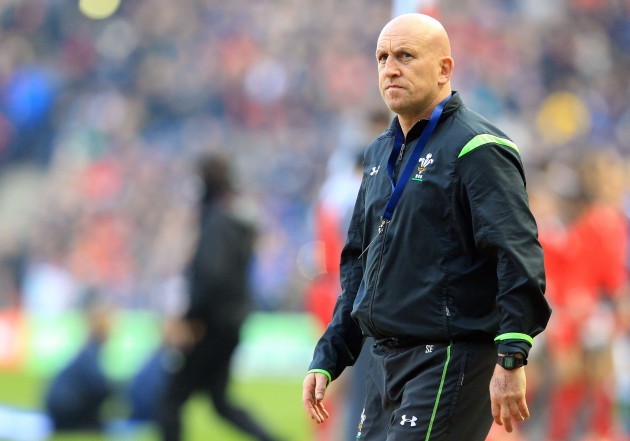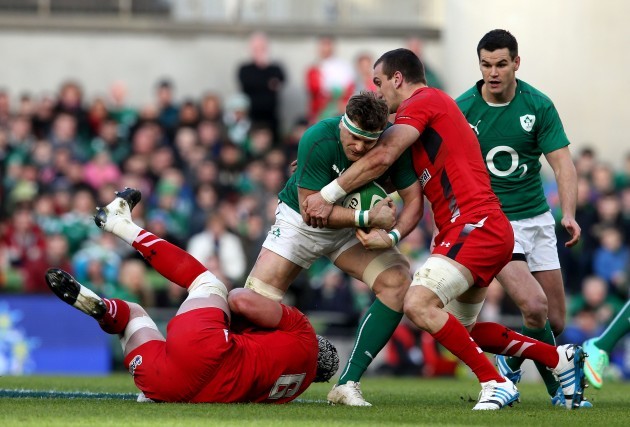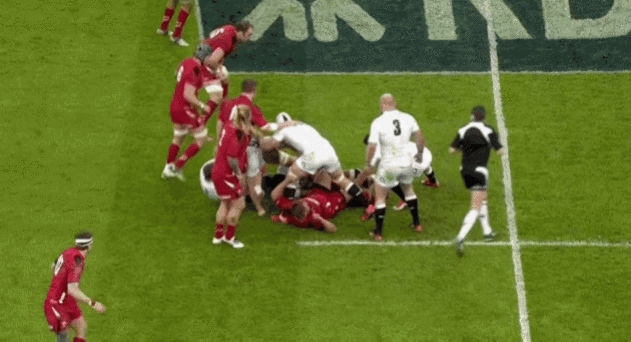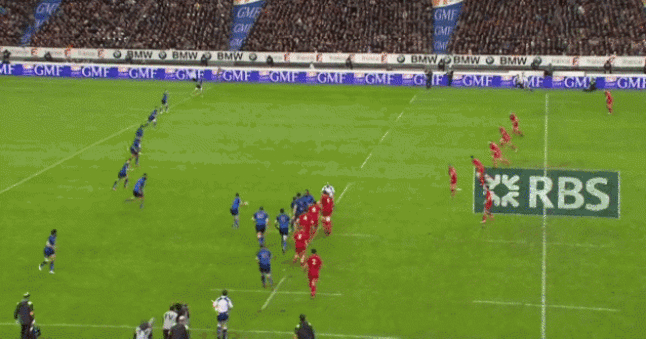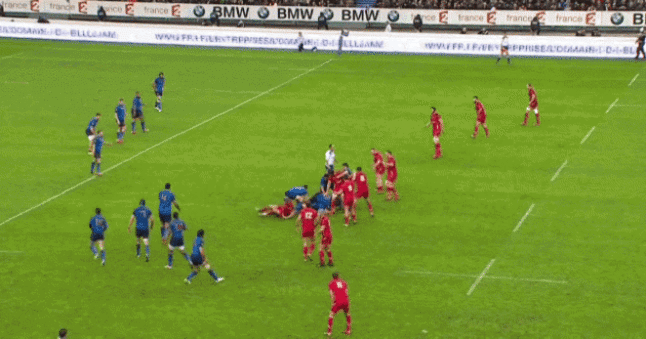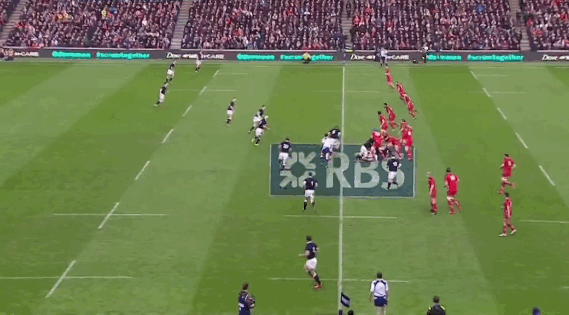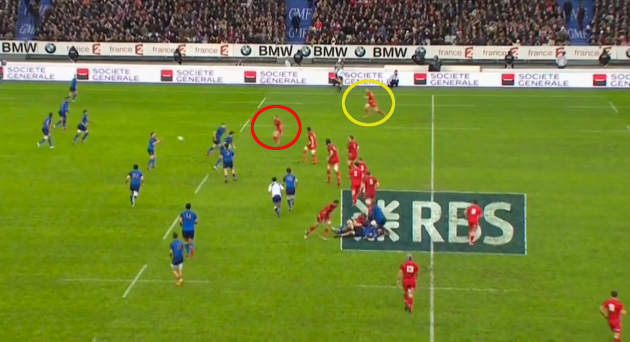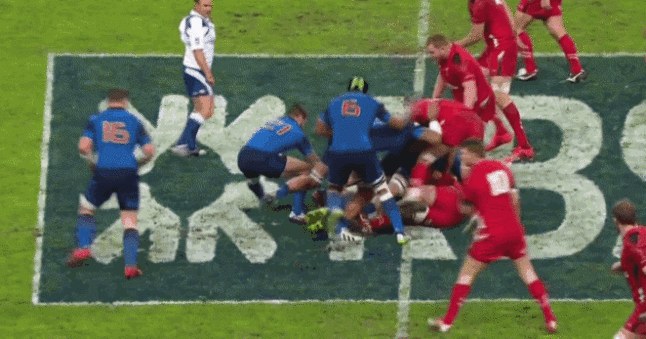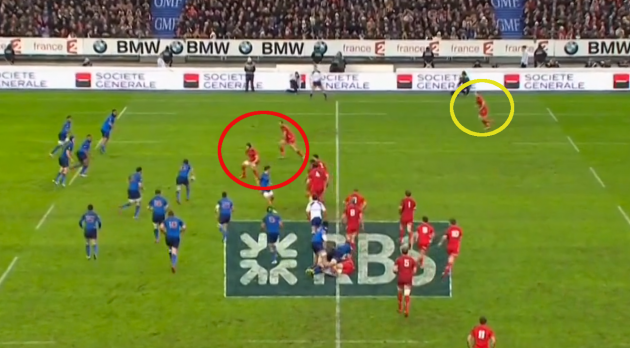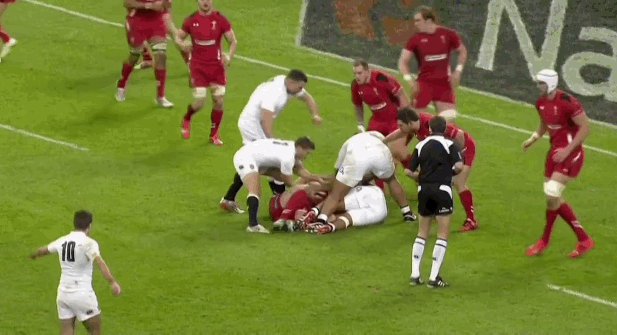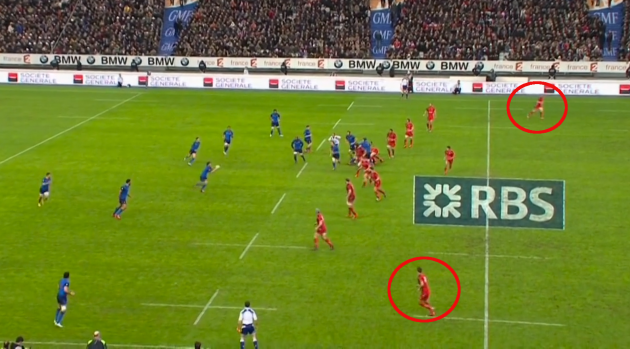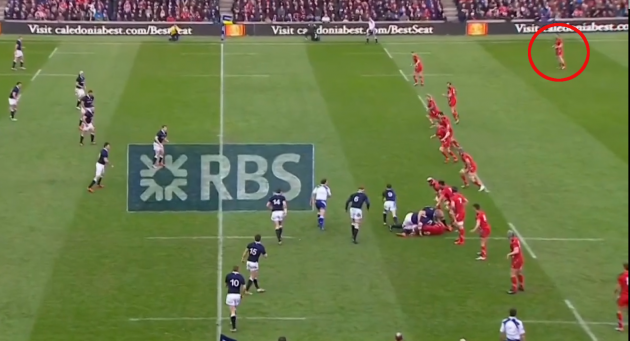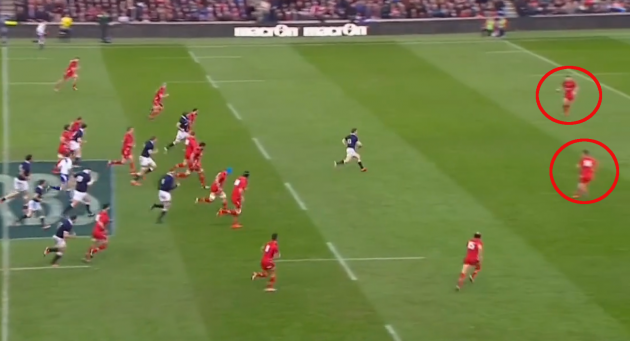“AT WIGAN, IT was permissible not to be in the line only if you had a serious injury or a broken leg. Otherwise you had to be there.”
The words of Shaun Edwards, Wales’ defence coach and a man who became a legend of rugby league during his playing days with Wigan Warriors. A native of the Greater Manchester town, Edwards remains one of the most successful league players of them all.
He achieved eight league [the Rugby Football League Championship as it was back then] successes and won nine Challenge Cups, as well as being the Man of Steel in 1990. He played for Great Britain a total of 36 times, and was even capped by Ireland once.
Moving into the rugby union coaching world almost immediately after retirement at the turn of the century, Edwards has been a major success in that field too. He won three Premierships and two Heineken Cups with Wasps, before two Grand Slams and a further Six Nations trophy with Wales as Warren Gatland’s right-hand man.
His philosophy on the game has naturally morphed and altered as he crossed rugby codes and adapted to the changing nature of the sport, but Edwards very much still believes in the traits that made Wigan’s defence great.
Old habits die hard
Defence in rugby is partly down to having the right systems, techniques and communication processes nailed down, but most important is that the players are devoted to the team’s cause.
That’s what the opening quote of this piece alludes to. Edwards understands better than anyone that a strong defence is built on work rate, players breaking their balls to get into the line and actually wanting to be alongside their teammates making tackles.
Similarly, Edwards demands aggression from his players in defence, knowing that without combativeness any system he builds is bound to fail.
Happily for the Wales defence coach, he works with a group of players who largely provide both of those elements, even if they have wavered at times since their 2013 Six Nations success.
With those prerequisites in place, Edwards demands that his players are quick at getting off the line in defence. They’ve been famous for this blitz style for years now, as were Wasps under Edwards, and it’s the best illustration of their aggressive edge.
The video above shows the Wales defence in action, although there are perhaps other examples where their linespeed [how quickly they come forward in defence] is even greater.
The idea is to get up in the attackers’ faces, force them to make decisions [or no decision at all] under pressure, and complete a strong tackle behind the gainline. When that happens, Wales can then compete ferociously for turnovers at the breakdown, or at least get in and slow the ball down.
On the first phase above, Taulupe Faletau rushes up to make a low tackle on England’s Dan Cole behind the gainline, allowing Sam Warburton to get over the ball instantly and slow it to a ruinous pace.
Phase two sees Wales get off the line at good speed again, eating up the first two metres with rapid feet, before Dan Biggar and Jake Ball tackle Luther Burrell and Jamie Roberts jackals to initiate the turnover.
Two England phases for a combined loss of around six metres, as well as a turnover. Major success for Edwards’ defence.
Chop and jackal
Wales love to compete at the breakdown and men like Sam Warburton, Gethin Jenkins and Dan Lydiate are strong in this area of the game, even if they have not been at their very peak in terms of steals during the current championship.
Amplifying the turnover threat is one of the reasons behind Wales’ linespeed, given that a dominant tackle behind the gainline is so favours the arriving defensive player over the attacking rucking player.
One thing that’s worth highlighting with Wales is the make-up and quality of their tackling. The tackle is obviously the primary action of defence, so it makes sense to dedicate lots of time to improving it.
Wales certainly do that under Edwards, who pushes his players to make strong hits around the legs of the opposition ball carriers. It seems an obvious thing to point out, but in a game where so many teams/players now have high tackle focus, Wales remain intent on taking out ankles and knees.
Look again at the video above and note how low Faletau and then Biggar and Ball go on the ball carrier. The attacker goes do deck almost instantaneously and that allows the next defender to get over the ball swiftly.
Beating the blitz
When a team rushes up hard in defence, it naturally leaves space in behind, and many point to the chip kick as the ideal way to exploit that.
We see above that George Ford finds that exact pocket of space in behind Wales’ advancing midfield defence, Jonathan Joseph chasing wonderfully and leaping to regather the kick.
It requires a pinpoint kick from the England out-half, but this success is also built upon Ford [or a player outside him] reading play and noting that Wales have no sweeper in behind the frontline.
Contrast that to the below example, when France attempt the kick despite Wales scrum-half Rhys Webb being in position as the sweeper.
We should point out that the above incident is the second time France attempted to chip against Wales, meaning Edwards’ defence had been forewarned. It’s centre Jonathan Davies who gathers this kick, he too was wary of that option and reacted accordingly, but Webb is also in position.
If we go back to France’s first attempt at the chip over Wales’ rush defence [below], we can see that they got much closer to a successful outcome.
In this instance, Webb has to sprint across from behind the ruck on his sweeping line, while the midfield defenders [a bunch of forwards here] read the situation less intuitively.
Mathieu Bastareaud almost claims Lopez’s dink over the top, but just spills the ball as Webb arrives. The point is that Ireland might only have one real chance at opening Wales up with a chip kick on Saturday, most likely early in the game.
If Webb fails to sweep and Ireland get Robbie Henshaw, Jared Payne or Rob Kearney under an accurate Johnny Sexton chip, they can open that Welsh defence up and possibly manufacture the crucial three/five/seven points that seem likely to decide the game.
It’s a high-risk tactic as the very fact that the kicking team rushes after the chip leaves them in potentially disjointed defensive shape should they fail to regather. This is certainly not going to be something Ireland look to do repeatedly, but it’s something Sexton will have in the back of his mind at the Millenium Stadium.
Picking the exact right moment is the key.
Playing through the bodies
Part of Wales’ blitzing system, like so many others, is to send their centres racing up at an even greater speed than the players around the fringes of the ruck.
This is common to any team with aggressive line speed, the player on the outside edge of the front line leading the charge up to shut down the wide passing options for the attack [as happens above].
That’s exactly what Jamie Roberts is attempting to do again in the situation above, despite Wales being at a numerical disadvantage [something we will return to again later in this piece].
Roberts is highlighted by the red circle in the image above, as France launch their attack. The Racing Métro centre is the last man on the edge of Wales’ front-line defence in this instance, George North [yellow] having been in a deeper position to cover a potential France kick from hand.
A quick count of the numbers on the right side of the defensive ruck and then France’s attacking players will tell you that Wales are outnumbered. Many defences in this instance would turn off their linespeed and use a drift system instead, but not Wales.
Roberts continues to come forward at pace even as Rabah Slimani sends a pass out the back door to Lopez, leaving a big dog leg in the defence. That is, there are holes for France to run into either side of Roberts and the France out-half opts to dart to the centre’s inside before offloading for a big linebreak.
We get something similar below from France, expect this time they take the space on Robert’s outside shoulder.
Here, both Roberts and Warburton shoot up hard and fast, again despite Wales being in a numbers-down defensive situation. They’re looking for man-and-ball tackles behind the gainline, but France’s hands do the trick to find the space on the edge.
Again, note North’s starting position deeper back from the front-line defence, a point we will return to in time.
The ‘risk’ France take in the example above is particularly relevant for Ireland as they look to exploit Wales’ tendency to shoot up in defence. Bastareaud and Fofana push their passes under intense pressure from Welsh defenders, but they get a gain from doing so.
Carrying at and passing into a blitz defence is not always a whole lot of fun, leaving the attackers open to being absolutely smashed in the tackle, but holding their nerve and drawing defenders into this type of dog leg can be hugely beneficial.
Even simple plays like delayed passes onto trail runners like that used by England above can be effective against a defence intent on coming up hard off the line.
Ford’s short pass to Kieran Brookes takes advantage of the fact that Davies is keen to rush up on opposite number Joseph, meaning it’s hard for the Wales 13 to turn back inside when he identifies Brookes as the primary threat.
Similarly, Roberts bursts up in the clip below, than finds it hard to physically react when Scotland’s Finn Russell spots the space just inside the centre.
It’s another example of a tiny dog leg in the Welsh defence, and Scotland should really score after the linebreak in this instance. Ireland will be reliant on kicking again on Saturday, but there will be opportunities with ball in hand too.
The danger of running at Wales’ blitz defence is always that they get dominant chop or body tackles in on the ball carriers and then hammer into the breakdown looking for those crucial turnovers, but Ireland have the composure to play in and around them.
Keeping a keen eye on the shooters will be key to their success and it may not take anything revolutionary to exploit them. Sometimes it’s simply about holding one’s nerve and taking the gap as it appears at the latest stage.
Again, identifying the ideal moment is essential.
Wing play
One of the major strengths of Wales’ defence in the years they achieved Grand Slam successes was the fact that they stacked their front-line defence with bodies and turned on maximal linespeed.
Simply put, the more defenders in the front line, the quicker and more confidently you can rush. With that in mind, Edwards often encouraged the Welsh wings to push forward and be part of the rush, rather than holding depth to cover the opposition kicking game.
That meant Wales often presented with one big line of defenders first up [as below], fullback Leigh Halfpenny asked to cover large swathes of the pitch in the backfield [out of shot here].
Ireland perfectly took advantage of that last year in Dublin, when Sexton delivered a masterful kicking performance to repeatedly find space deep behind the Welsh wings, essentially pinning them into their own half and ensuring Ireland dominated the territorial battle.
It was a harsh lesson for Wales and Edwards, and it appears they have made big efforts to adapt their defensive style as a result.
The result is a more fluid defensive system that is far harder to read and demands even greater kicking and decision-making accuracy from the opposition.
We have highlighted the Wales wings, George North and Liam Williams, in the image above, with both wide men hovering back behind the front line defence and holding deeper in case of a French kick.
It’s worth stressing that this is not something that Wales never did before, but their tendency was to rush up earlier and join the front line even before it was obvious that the opposition were indeed looking to run the ball rather than kick.
Wales just aren’t giving cues to the opposition decision makers as easily as they have in the past. There is less early rushing up to join the frontline, meaning the opposition kickers are forced into later decisions, therefore potentially reducing the effectiveness of their kicking if they do opt kick the ball.
When Wales hold their wings in deep positions, it obviously means less players in the front line and in that regard, Ireland need to be on the lookout for opportunities to move the ball wide and exploit the shooters in wider channels, as we highlighted France doing earlier.
Fewer bodies in the line often means a less effective blitz, so Ireland’s players must be consistently aware of what Wales’ wings are doing. It’s a team responsibility, although much of the pressure will lie on Sexton’s shoulders.
His ability to read the game provides confidence for Ireland. The expectation is that Wales will lie deep early in the game to prevent Sexton from eating up field position with his kicking game, as he has done throughout this championship.
If that proves the case, Ireland must be prepared to run the ball in a clinical fashion.
Dual cover
And yet, Wales don’t always have their wings in deep positions this season, which brings us back to the increased fluidity of their defence.
As we see above, the Wales wings have pushed into a position almost right up in the frontline defence, with Dan Biggar and Halfpenny [out of shot] holding deep positions to cover any French kicks.
In the past, this duty was often left solely to Halfpenny, who performed superbly at it thanks to his sublime positional play. Still, it was an occasional weakness for the Welsh, as opposition out-halves with accurate long kicking games would invariably find space on either side of the fullback.
The current Wales are more aware of the need to cover space in deep positions, and so they often drop a second man to the backfield.
What does it mean for Ireland? The kicking game will have to be pinpoint accurate, although there is again confidence in Sexton and Conor Murray’s ability in that regard.
It also means that Wales are better set up to counter-attack at times, something that Ireland will need to be wary of as they chase kicks on Saturday.
The real key for Ireland in all of this is their decision-making in attack. They will look to use power plays and set moves to break down the Wales defence from set-piece, but there are big gains to be had in phase play too.
A constant awareness of how Wales are set up in the backfield is crucial. Kicking will be prominent again of course, but Wales’ shifting system in the last year means they are more susceptible to being attacked with ball in hand than before.
Williams, North and Halfpenny are all strong in the air, as are Biggar and Roberts, although Ireland will of course look to rule that aspect of the game once again. But when those wings drop deeper, Ireland must be ready to pounce and take those risks to exploit the space on the outside edge.
Another tactical battle awaits.
